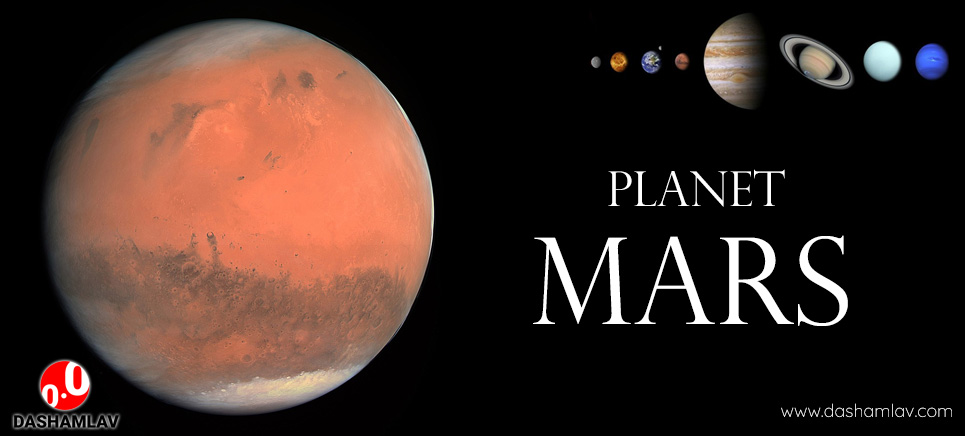In our solar system, Mars is the fourth planet closest to the Sun. It is easily identifiable from Earth for the most part of the year. Mars is the second smallest planet of our solar system after Mercury. It shares similarities with Earth in many ways including the average rotational period. The surface of Mars appears red from a distance. This is why Mars is also called the red planet. Mars has two moons: Phobos and Deimos. Earth is twice the size of Mars and ten times heavier in mass than it.
Facts about Mars
1. Mars has a very thin layer of atmosphere
The thin atmospheric layer majorly consists of carbon dioxide. One of the theories suggests that reasons like absence of a global intrinsic magnetic field and lighter gravity of Mars are responsible for making its atmosphere vulnerable. The thin atmospheric layer succumbs to the pressure of the solar wind. In fact, as per this theory, the atmospheric layer of Mars has been thinning constantly for over a million years. This theory is still being investigated by NASA through MAVEN Mission. Interestingly, while the Martian atmosphere is a hundred times thinner than Earth, it still has the capability to support winds, clouds, and weather.
2. Mars is like a vast cold desert
A thin layer of atmosphere and significant distance from the Sun are the primary reasons responsible for low average temperature on Mars. The average temperature of Mars is minus 80 degrees to minus 60 degrees Fahrenheit. The temperature at poles varies between minus 195 degrees to minus 125 degrees Fahrenheit. While it remains close to 70 degrees Fahrenheit near the equator.
3. Mars has Earth-like orbit and its axis is tilted in relation to the Sun.
The axial tilt of Mars is very similar to that of Earth. The inclination of Mars is 25.19° to its orbital plane. The degree of this axial tilt changes significantly across hundreds of thousands to millions of years.

4. Mars is named after the Roman god of war
It is believed that Romans were well aware of some known celestial bodies apart from the Sun and the Moon. Taking inspiration from Greeks, they named the known celestial bodies after their gods. Romans named the red planet after their god of war, Mars. As per the mythology, Roman god Mars rode on a chariot. His chariot was pulled by two horses named Phobos and Deimos. Thus, the two moons of Mars were accordingly named after them.
5. The strongest evidence suggests the presence of liquid water on Mars
NASA’s Mars Reconnaissance Orbiter (MRO) has recently brought to light some pieces of evidence confirming the rich history of water-related processes. Evidence of hot springs has been one of the major discoveries so far. A huge lake nestled under the ice cap at the southern pole of Mars has also been reported. It is a 20-km wide lake of liquid water underneath solid ice in the Planum Australe region. These are some of the strongest evidence suggesting the presence of liquid water on Mars.
6. Days are pinkish-red and sunsets are blue on Mars
The atmosphere of Mars is made up of carbon dioxide and lots of dust. The fine dust of the Martian atmosphere tends to scatter the red light of the visible spectrum. This is the reason we see a pinkish-red or red sky. During sunsets, the light has to travel longer distances within the atmosphere so it scatters even further. The color which is left is the color which is visible to our eyes. Fine dust closer to Sun’s part makes the blue light much more prominent and we get to see a blue sunset on Mars.
7. Mars is home to the second-tallest mountain of our solar system
Olympus Mons is a shield volcano on Mars that is about 2.5 times the size of Mount Everest. The height of Olympus Mons was measured through Mars Orbiter Laser Altimeter and it was estimated to be over 21 km high. The size of Olympus Mons makes it the second-highest mountain of our solar system so far. It is located in the western hemisphere of Mars.
8. Planet Mars is Bright!
After Sun, the Moon and planet Venus, the Mars is the brightest celestial body when observed from Earth. Its apparent magnitude reaches −2.94.
Statistics about Planet Mars
| PROPERTY | VALUE |
|---|---|
| Mars’ radius | 3,389.5 km |
| Mars’ surface area | 144.8 million km² |
| Mars’ volume | 1.63 x 1011 km3 |
| Mars’ mass | 6.42 x 1023 kg |
| Mean density | 3.93 g/cm³ |
| Mars’ average distance from Sun | 229 million km |
| Perihelion (closest distance to Sun) | 206 million km |
| Aphelion (farthest distance from Sun) | 249 million km |
| Length of solar day (single rotation on its axis) | 25 hours |
| Length of year (single revolution around the Sun) | 687 days |
| Equatorial inclination to orbit (axial tilt) | 25.19 degrees |
| Rotation speed at Equator | 868.22 km/h (241.17 m/s ) |
| Surface gravity | 3.72076 m/s2 |
| Escape velocity | 5.03 km/s |
| Natural satellite | Mars has two natural satellites: Phobos and Deimos |
| Mars’ composition | 95.32% Carbon dioxide
2.7% Nitrogen 1.6% Argon 0.13% Oxygen 0.08% Carbon monoxide Also, minor amounts of water, nitrogen oxide, neon, hydrogen-deuterium-oxygen, krypton and xenon |
Use the citation below to add this article to your bibliography
"Planet Mars: Interesting Facts about the Red Planet." Dashamlav.com. Web. 12 June 2025. <https://dashamlav.com/planet-mars-interesting-facts-red-planet/>
Dashamlav.com, "Planet Mars: Interesting Facts about the Red Planet." Accessed 12 June 2025. https://dashamlav.com/planet-mars-interesting-facts-red-planet/
"Planet Mars: Interesting Facts about the Red Planet." (n.d.). Dashamlav.com. Retrieved 12 June 2025 from https://dashamlav.com/planet-mars-interesting-facts-red-planet/
